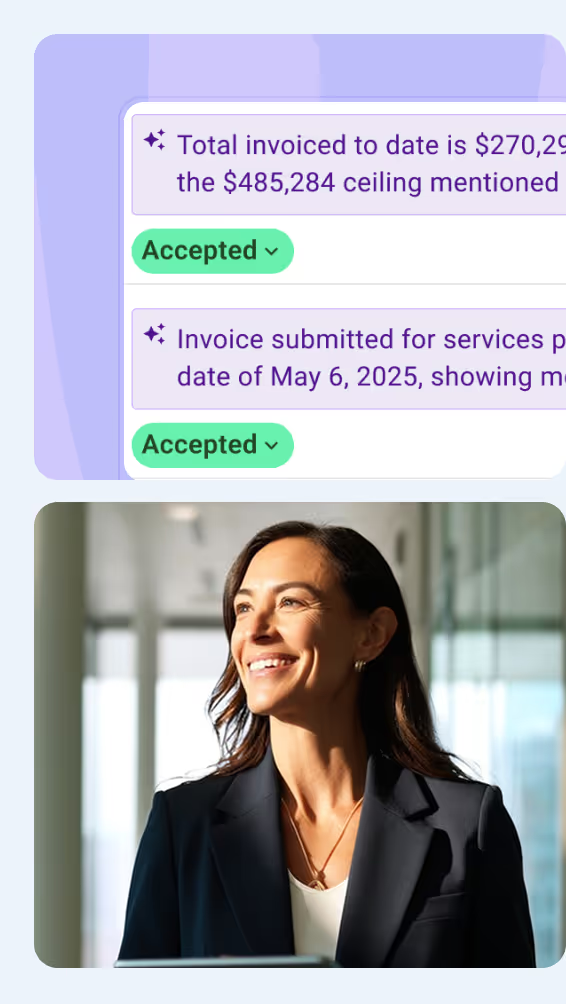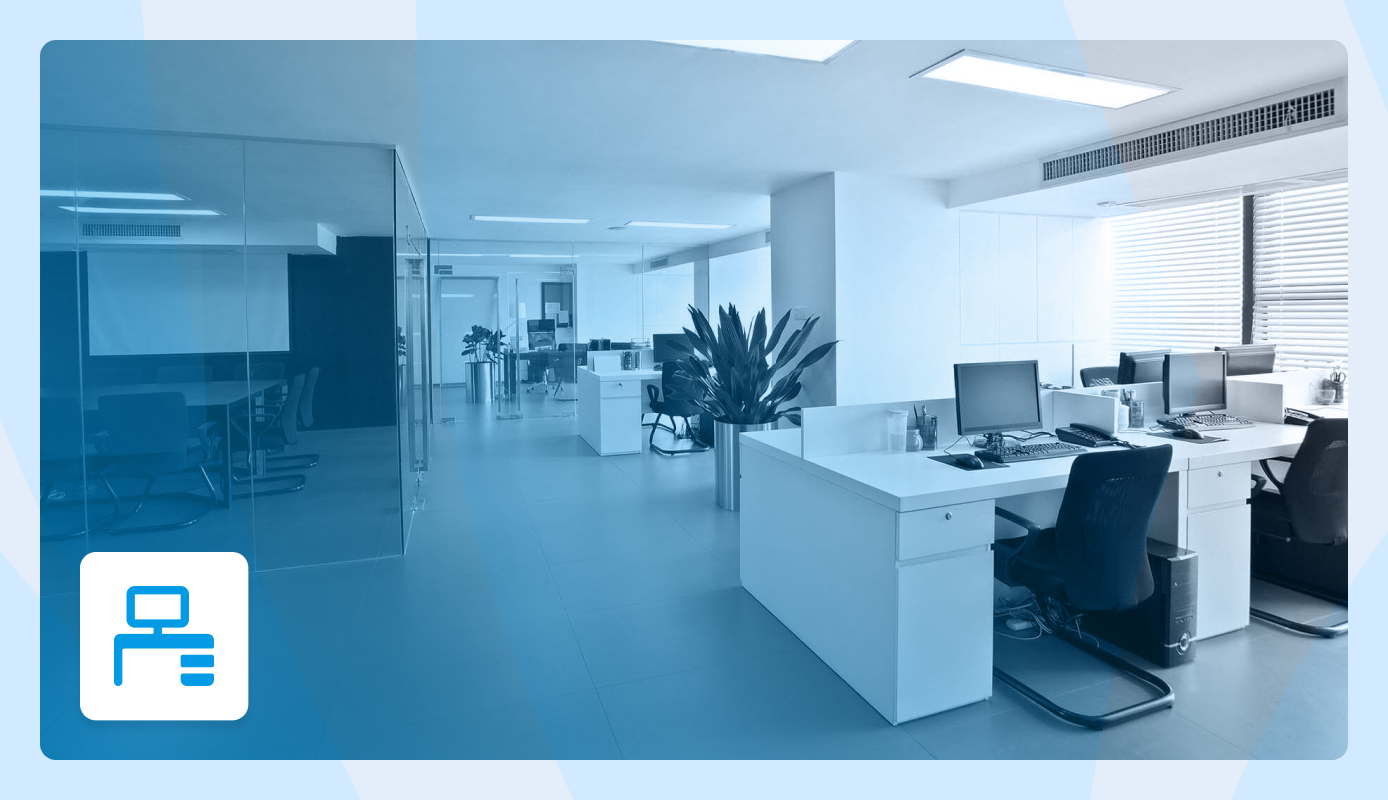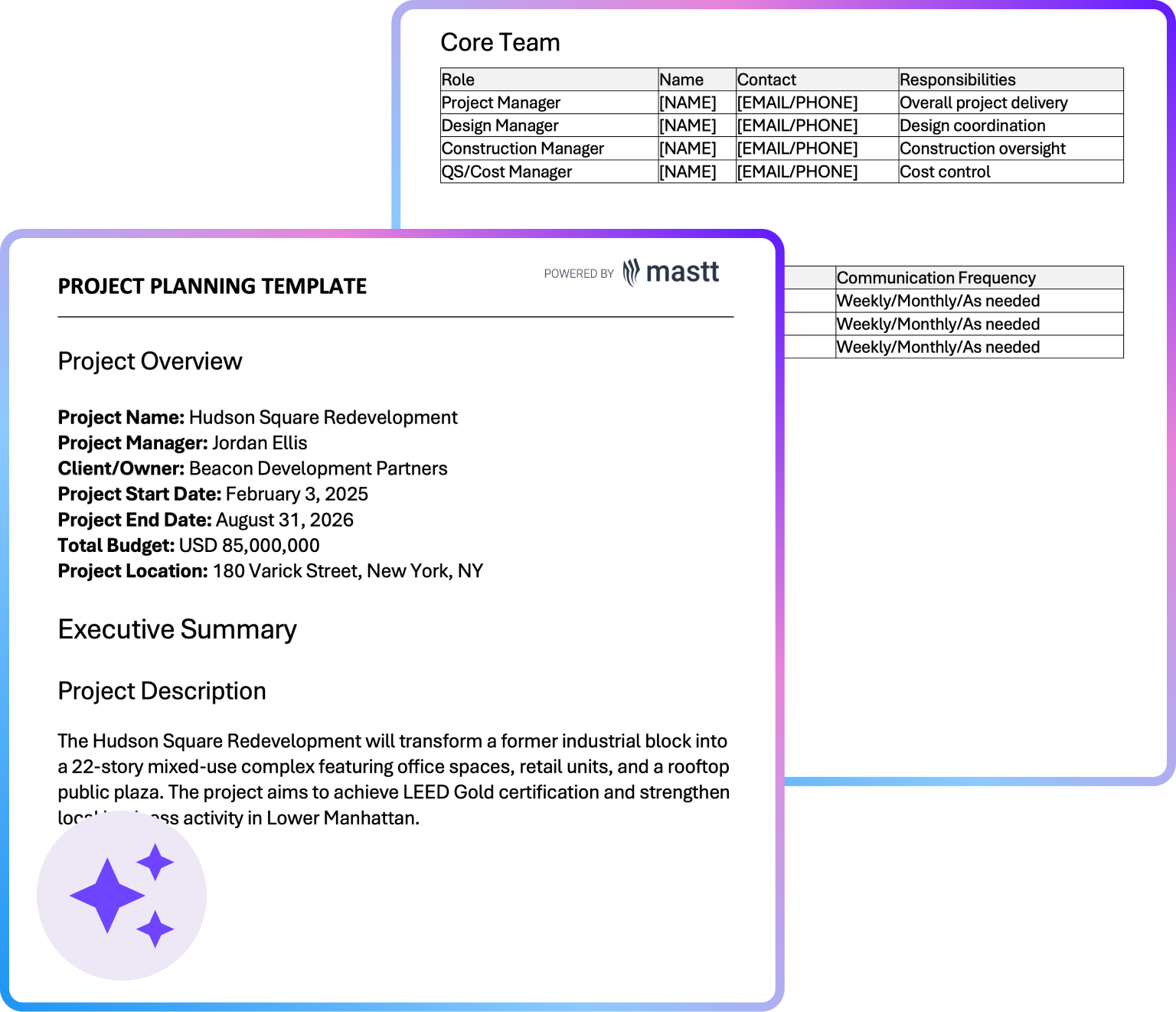An office fit out transforms an empty space into a functional and well-designed workplace. It’s where strategy meets design, combining layout, technology, and comfort to create spaces that support the way people work.
This guide explains what an office fit out involves, how much it costs, and the key decisions that help you build a workspace for today’s evolving work environment.
What is an Office Fit Out?
An office fit out is the process of turning an empty or unfinished interior into a fully functional workspace. It involves adding essential elements that bring the space to life, such as walls, ceilings, floors, lighting, and building systems.
In essence, a fit out transforms a bare interior into an environment shaped around how people work, collaborate, and move. It bridges design and construction to create a space that balances comfort, efficiency, and visual appeal.
The goal of an office fit out is to build a workplace that enhances employee productivity and well-being while expressing the company’s identity. Every aspect of the interior works together to deliver a cohesive, high-quality office space.
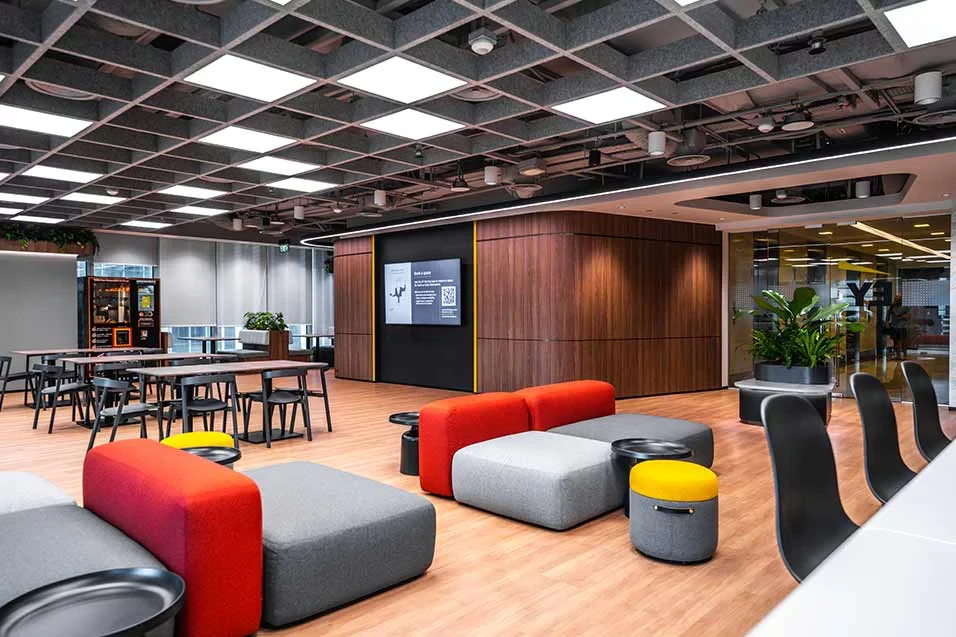
Benefits of a Successful Office Fit Out
An office fit out improves how people work, how space is used, and how a business performs. When design, layout, and function align, the workplace becomes a strategic asset that supports both productivity and well-being.
- Boosts Productivity: Efficient layouts, ergonomic setups, and quality lighting help employees stay focused and perform better.
- Enhances Wellbeing: Comfortable, well-ventilated spaces with natural light support health, satisfaction, and retention.
- Maximizes Space Efficiency: Smart planning reduces wasted areas and makes it easier to adapt to hybrid or changing work needs.
- Strengthens Brand Identity: Thoughtful design elements reflect company culture and leave a positive impression on clients and staff.
- Improves Sustainability: Energy-efficient systems and eco-friendly materials lower operational costs and environmental impact.
- Increases Property Value: A professional fit out elevates the quality and market appeal of your commercial space.
The real advantage of office fit outs is their lasting impact. A flexible, efficient workspace continues to add value long after the project is complete. It adapts to changing business needs, reduces future renovation costs, and helps maintain a positive, motivated workforce.
4 Types of Office Fit Outs
Office fit outs are typically classified into Shell and Core, Category A, Category B, and Turnkey types. Each one represents a different stage of completion, from an unfinished structure to a fully equipped workspace ready for occupation.
Here’s a detailed look at each office fit out type and what sets them apart.
- Shell and Core: The developer delivers only the essential structure of the building. This includes the main framework and shared mechanical or electrical systems. The interior of each office unit remains unfinished, leaving tenants to complete all interior work.
- Category A Fit Out: A partially completed office provided with functional but standard finishes. It includes features like suspended ceilings and basic lighting. The space is usable but neutral, intended as a blank canvas for tenants to design and furnish.
- Category B Fit Out: A fully customized workspace built to the tenant’s exact needs. It involves interior design, branding, technology, and layout planning. This type creates a finished environment that reflects the company’s culture and operational requirements.
- Turnkey Fit Out: A comprehensive solution where one provider manages the design, build, and delivery. The client receives a ready-to-use office that’s fully fitted, furnished, and equipped for immediate occupation.
These types distinguish the scope of work and responsibility between landlords, tenants, and contractors. Knowing which type applies helps clarify what’s included in a project and what remains to be done before the office becomes operational.
Office Fit Out Process: Step-by-Step
The office fit out process starts with defining goals and space requirements, then moves through design, budgeting, and construction. Each stage ensures the workspace is efficient, compliant, and tailored to how the project team works.
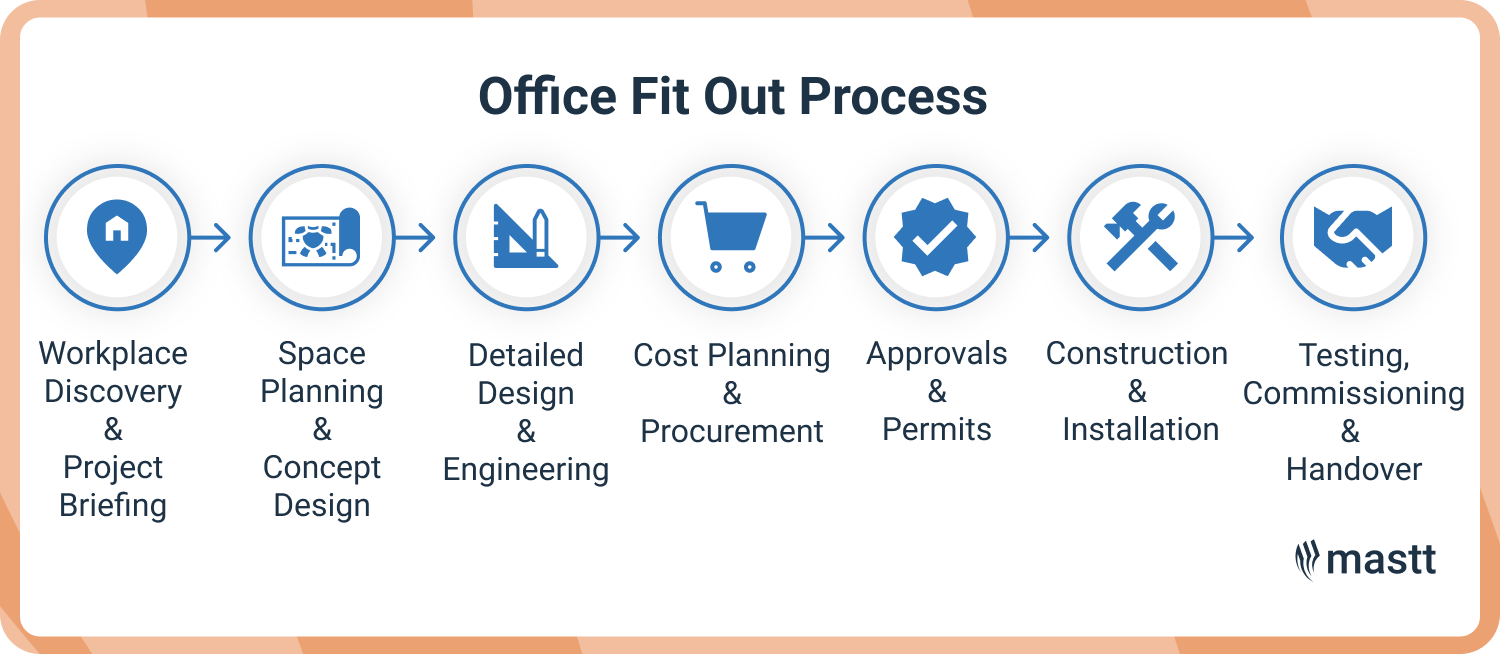
Step 1: Workplace Discovery and Project Briefing
This is where the vision takes shape. The project team defines objectives, workspace requirements, and how employees will use different areas. Setting a clear construction budget and timeline at this stage guides every decision that follows.
💡 Pro Tip: Use occupancy and utilization data from your current office to inform planning. Data-backed insights on desk usage, meeting room demand, and movement patterns help create a layout that fits real behavior.
Step 2: Space Planning and Concept Design
At this stage of the office fit out, ideas turn into tangible layouts that shape how people work and interact. Designers develop floor plans that balance open collaboration areas with private work zones.
- Test-fit layouts show how teams and furniture will occupy the space.
- Visual concepts explore color, lighting, and materials to create a cohesive atmosphere.
Coordination with engineers begins here to align furniture placement, electrical outlets, and HVAC systems with the proposed design. Decisions made at this point directly influence buildability, compliance, and costs.
💡 Pro Tip: Integrate technology planning from the start. Position data cabling, server access, and AV setups during concept design to avoid costly redesigns.
Step 3: Detailed Design and Engineering
In this phase, the office fit out design becomes highly technical and detailed. Architects and engineers refine layouts and coordinate building systems. Compliance with local construction codes, fire safety, and accessibility standards ensures the space meets both legal and operational needs.
Step 4: Cost Planning and Procurement
This stage brings financial control to creative ambition. Project managers develop a cost management plan, source contractors, and confirm material lead times. Comparing bids on value ensures quality outcomes.
- Include contingency funds for design revisions or unforeseen site conditions.
- Track costs continuously using project management software to stay within budget.
Run a value-engineering workshop before finalizing specifications. Involve both designers and contractors to identify material swaps or modular systems that reduce cost without compromising aesthetics or performance.
Step 5: Approvals and Permits
Before office fit out construction starts, the design must be reviewed and approved by landlords and local authorities. Building control bodies, planning departments, or fire safety officers may need to sign off. Smooth coordination with these entities prevents compliance issues.
Step 6: Construction and Installation
This is where the fit out comes to life. Contractors build walls, install ceilings and flooring, and integrate building systems. As furniture, fixtures, and branding elements arrive, the office begins to reflect the company’s identity and workflow.
Closely supervise the construction. Regular visits help ensure workmanship quality, adherence to specifications, and timely issue resolution.
Step 7: Testing, Commissioning, and Handover
Every system is tested to confirm performance and safety. MEP inspections verify functionality, while punch lists address any remaining issues. Once approved, the client receives operation manuals, warranties, and a space ready for occupancy.
💡 Pro Tip: Conduct a post-occupancy evaluation 6-12 weeks after move-in. Real user feedback on acoustics, lighting, and space flow helps fine-tune performance and informs future projects.
An effective office fit out depends on coordination as much as craftsmanship. When designers, engineers, and construction teams work in sync, the result is an efficient workspace that delivers long-term value.
How Much Does an Office Fit Out Cost?
Office fit out costs differ widely across regions and project types. Location, size, design quality, and building condition all influence the final figure. Recent benchmarking by JLL and Turner & Townsend’s global fit out cost studies reveal an average of about USD 1,950 per square meter for a typical office fit out.
Actual costs, however, often vary depending on project scope, design quality, and regional market conditions. To give a clearer picture, here’s what businesses typically spend on fit out based on office quality and specification.
In global business hubs such as London, New York, Singapore, and Sydney, costs often sit near the top of these ranges. Labor rates, import duties, and building regulations push prices higher. By contrast, secondary cities or emerging markets can achieve similar standards for less.
Beyond geography, design ambition plays a major role. Choosing sustainable materials, advanced climate systems, or smart lighting increases initial costs but can reduce energy bills and maintenance later. A well-planned fit out should balance both.
Factors to Consider Before Planning a Fit Out for a Commercial Office
When planning a fit out for a commercial office, the most important factors to consider are budget, timeline, and building condition. You’ll also need to think about space requirements, among others.
The most important points to evaluate include the following:
- Budget and Cost Control: Set a realistic financial plan early. Include design fees, materials, labor, and fit out items such as partitions, lighting, and furniture.
- Timeline and Scheduling: Define move-in dates and account for lead times on materials, landlord approvals, and inspections. Building control approval in the UK or local authority permits in the US can add several weeks to the program.
- Building Condition and Services: Review the existing shell-and-core or Category A fit out. Check HVAC capacity, electrical load, and data cabling routes to confirm compatibility with the new design.
- Workplace Strategy and Space Needs: Analyze how teams use different areas. Plan for open collaboration spaces, quiet zones, and hybrid work areas that align with modern office standards.
- Regulatory and Compliance Requirements: Ensure the design meets relevant codes such as the UK’s Building Regulations Part B (fire safety) or US standards like the NFPA life safety codes.
- Sustainability and Energy Efficiency: Incorporate low-energy lighting, efficient HVAC systems, and recycled materials. Certifications can guide sustainable design choices.
These considerations are interconnected. Local regulations can affect the design approach, while budget and existing building services shape what’s achievable. Addressing each element early helps deliver a compliant, efficient, and future-ready office fit out.
What are the Latest Office Fit Out Design Trends?
Office design in 2025 focuses on flexibility, wellbeing, and sustainability. Businesses are rethinking how space can support collaboration, concentration, and comfort while adapting to hybrid work models.
Here are the up-to-date design trends shaping modern office fit outs:
Modern office fit outs are shifting from static spaces to adaptable ecosystems. By exploring these trends before meeting a designer, you can clearly express your priorities and ensure the final workspace feels both functional and inspiring.
How to Choose the Right Office Fit Out Contractor
Finding the right contractor determines how smoothly your office fit out will run. The best firms bring deep expertise in workspace projects, manage complexity with precision, and understand how design and business needs to align.
When comparing potential partners, focus on these factors:
- Specialization in Office Fit Outs: Prioritize fit-out contractors who focus on office interiors. They understand the requirements of the modern workplace, from acoustics and lighting to ergonomics and brand integration.
- Proven Project Portfolio: Review completed fit outs similar in size, budget, and specification. Visit a finished site to assess build quality and attention to detail.
- Design and Build Integration: A general contractor offering both design and construction can streamline coordination. This reduces miscommunication between designers, engineers, and builders.
- Budget Accuracy and Cost Transparency: Request an itemized quote that covers materials, labor, furniture, and contingencies. Fit out costs can shift quickly, so clarity at the start prevents overruns.
- Program and Schedule Management: Look for strong planning capability. Office fit outs often work within tight move-in dates, and a disciplined contractor keeps every stage aligned.
- Quality Control and Handover Standards: Ask about inspection procedures, snagging processes, and aftercare. A good contractor ensures systems, finishes, and furnishings meet performance expectations before handover.
Selecting a contractor for an office fit out goes beyond comparing prices. The right team brings technical skill, workplace insight, and a collaborative mindset that ensures the space performs beautifully once occupied.
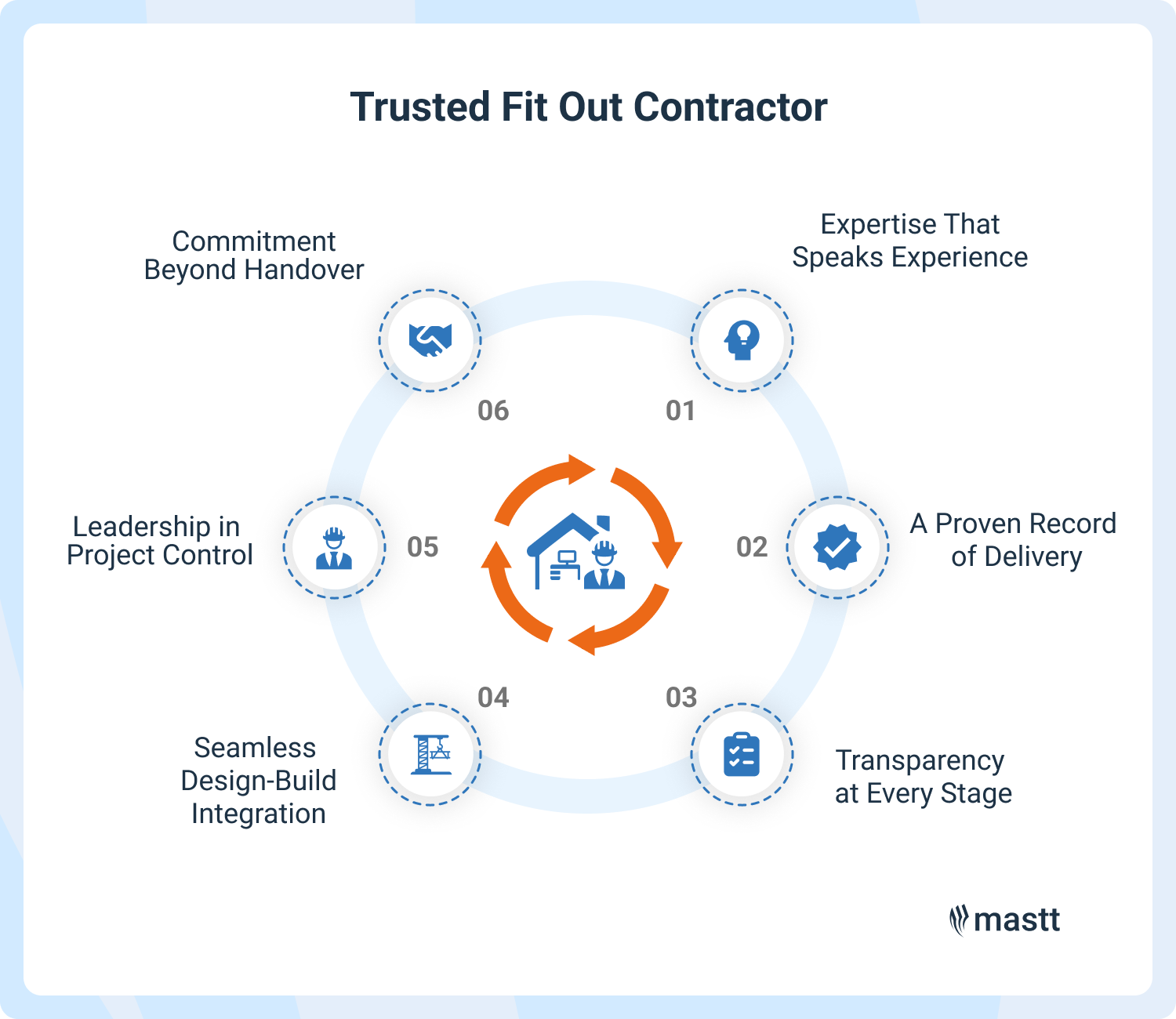
Turn Office Fit Outs into Lasting Value
An office fit out is ultimately about people, how they work, connect, and thrive together. When a workspace is designed with care, it becomes an environment that inspires creativity, collaboration, and pride.
Whether you are transforming an existing office or creating a new one, plan with intention and choose trusted professionals. Create a space that reflects your company’s values and supports the people who bring them to life.





